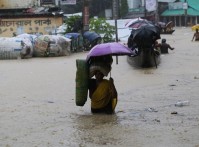
“I’m an optimist,” said
Peter McCornick, director for water policy at Duke University’s Nicholas Institute, about the future of food and water security in the Ganges and Mekong river basins at the World Wildlife Fund’s recent
two-day symposium on water and climate change (
video). Although the basins are under threat not only from climate change, but also
urbanization,
industrialization,
development, and
population growth, he maintained there are solutions, “as long as we understand what is going on.”
Whereas big-picture discussions of Asia’s glaciers and rivers often start and end with “fewer glaciers = less water,” McCornick argued that the connection is not so simple. Glacial melt “is particularly important in the Indus,” he said, but not so for the Ganges or Mekong.
“The Ganges is basically a monsoon-driven river,” said McCornick, and only 6.6 percent of the Mekong’s waters have glacial origins. Predicting the effects of climate change on monsoons is “extremely difficult.” Periods of heavy and light rains will be more pronounced in the Mekong, and how and when upstream dams will release water—a possibly more serious issue (video)—is unknown.
Food security will be impacted by shifting water supplies in the Ganges and Mekong. Within the Ganges basin, India’s population—already the region’s most water-stressed—could see its yearly water supplies drop by a third, from 1,506 m3 per person today to 1,060 m3 per person by 2025. “This is still a lot of water,” McCornick said, but water efficiency must undergo dramatic improvements if food supplies are to keep up with population growth.
In contrast, the Mekong could have too much water. Eighty-five percent of the Mekong delta, located in Vietnam, is under cultivation and its staple crop and principal food export, rice, is highly susceptible to flooding, which could increase due to extreme rain events, rising sea levels, or dam releases.
The Mekong basin is also the world’s largest freshwater fishery, but the effect of dams on the migratory pattern of the basin’s 1200-1700 fish species is still unknown. The industry is valued at $2-3 billion each year, said McCornick, and declining fish populations will not only harm local food security, but local livelihoods as well.
Adaptation strategies to cope with shifts in water supply brought about by climate change must be implemented by individuals at the local level, said McCornick, who urged that future adaptation research concentrate on sub-basins. Specific adaptation strategies to be explored include:Uncertainty is not an excuse for inaction, said McCornick, and we must begin adapting and developing new strategies now if we are to prevent the worst impacts of climate change and poor water management practices in the future.
Photo: Top, Mekong River Delta; Bottom, Mekong River Delta post-floods from heavy rains. Courtesy NASA.
 “I’m an optimist,” said Peter McCornick, director for water policy at Duke University’s Nicholas Institute, about the future of food and water security in the Ganges and Mekong river basins at the World Wildlife Fund’s recent two-day symposium on water and climate change (video). Although the basins are under threat not only from climate change, but also urbanization, industrialization, development, and population growth, he maintained there are solutions, “as long as we understand what is going on.”
“I’m an optimist,” said Peter McCornick, director for water policy at Duke University’s Nicholas Institute, about the future of food and water security in the Ganges and Mekong river basins at the World Wildlife Fund’s recent two-day symposium on water and climate change (video). Although the basins are under threat not only from climate change, but also urbanization, industrialization, development, and population growth, he maintained there are solutions, “as long as we understand what is going on.” A Publication of the Stimson Center.
A Publication of the Stimson Center.







